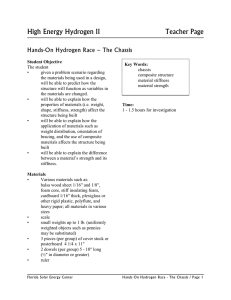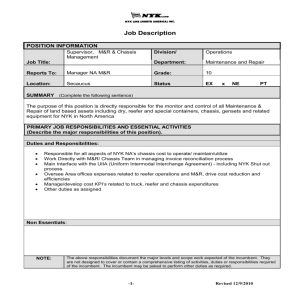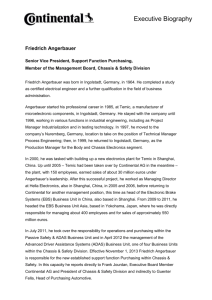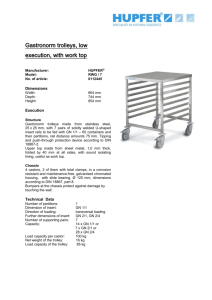High Energy Hydrogen III Teacher Page Hydrogen Sprint – The Chassis
advertisement
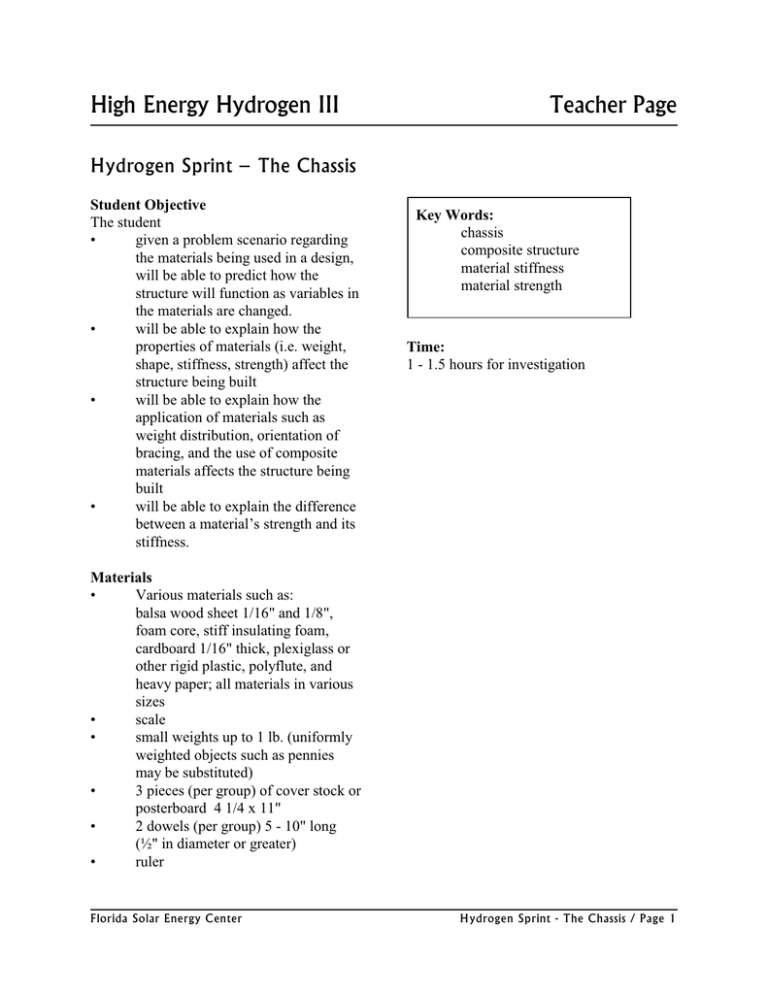
High Energy Hydrogen III Teacher Page Hydrogen Sprint – The Chassis Student Objective The student • given a problem scenario regarding the materials being used in a design, will be able to predict how the structure will function as variables in the materials are changed. • will be able to explain how the properties of materials (i.e. weight, shape, stiffness, strength) affect the structure being built • will be able to explain how the application of materials such as weight distribution, orientation of bracing, and the use of composite materials affects the structure being built • will be able to explain the difference between a material’s strength and its stiffness. Key Words: chassis composite structure material stiffness material strength Time: 1 - 1.5 hours for investigation Materials • Various materials such as: balsa wood sheet 1/16" and 1/8", foam core, stiff insulating foam, cardboard 1/16" thick, plexiglass or other rigid plastic, polyflute, and heavy paper; all materials in various sizes • scale • small weights up to 1 lb. (uniformly weighted objects such as pennies may be substituted) • 3 pieces (per group) of cover stock or posterboard 4 1/4 x 11" • 2 dowels (per group) 5 - 10" long (½" in diameter or greater) • ruler Florida Solar Energy Center Hydrogen Sprint - The Chassis / Page 1 Procedure 1. Have a box of various materials available so that students can pick their own investigation materials. 2. Students should work in their Sprint teams (2 - 6 students). 3. Ask the class what is meant by the term chassis. Make sure that they can differentiate between chassis materials and body materials. For example, a plastic soda bottle may make an excellent body, but a lousy chassis, since it would be difficult to attach the axles, wheels, motors and gears to it! 4. Discuss with students the difference between stiffness and strength. 5. Lead the class in a discussion of how normally weak materials can be made stronger and how normally flexible materials can be made stiff (examples can include corrugation, bracing, rolling in a tube, folding in a fan shape, etc.) 6. Pass out dowels and weights to the groups. 7. Students should complete the exercises in their Laboratory Manual. 8. Give teams time to discuss how they plan to incorporate these findings in their vehicle designs. 9. Teams should sketch their ideas in their team journals. 10. If time permits, and they feel ready, teams may begin to construct their vehicles. Note: Next investigation will be on wheels, axles and bearings. Announce to the class that they might want to bring some wheels from home to use with their investigations. Florida Solar Energy Center Hydrogen Sprint - The Chassis / Page 2 High Energy Hydrogen III Florida Sunshine Standards Benchmarks Hydrogen Sprint – The Chassis .1 The Nature of Science Standard 1 SC.H.1.4- Standard 2 SC.H.2.4- Standard 3 SC.H.3.4 .2 .3 .4 .5 .6 .7 .8 X X X M athematics: M A.B.1.4.1 Benchmark SC.H.1.4.1 - The students knows that investigations are conducted to explore new phenomena, to check on previous results, to test how well a theory predicts, and to compare different theories. Benchmark SC.H.3.4.1 - The students knows that technological problems often create a demand for new scientific knowledge and that new technologies make it possible for scientists to extend their research in a way that advances science. Benchmark SC.H.3.4.6 - The student knows that scientific knowledge is used by those who engage in design and technology to solve practical problems, taking human values and limitations into account. Benchmark MA.B.1.4.1 - The student uses concrete and graphic models to derive formulas for finding perimeter, area, surface area, circumference, and volume of two- and three-dimensional shapes, including rectangular solids, cylinders, cones and pyramids. Florida Solar Energy Center Hydrogen Sprint - The Chassis / Page 3 High Energy Hydrogen III Key Word/Definitions Hydrogen Sprint – The Chassis chassis – the component that must provide structural support for the motor, wheels, axles, etc. composite structure – a structure made of two or more materials glued or bonded together material stiffness – the quality of being unbending or lacking in suppleness. Stiffness does not necessarily mean strength. material strength – the quality of holding up against weight, tension or pressure. Strength does not necessarily include stiffness. strength to weight ratio – a way to describe a material’s properties that compares its strength and weight. This is an easy way to compare the relative merits of several different materials. For example, in Hydrogen Sprint cars you may be looking for a material that has a high strength value and a low weight value. Florida Solar Energy Center Hydrogen Sprint - The Chassis / Page 4 High Energy Hydrogen III Laboratory Manual Hydrogen Sprint – The Chassis The chassis for your car is the underlying structure that will provide support for the motor, wheels, axles, gearing and body. 1. Discuss with your team materials that you could use for your chassis. List some of your ideas below that you would like to investigate further. Test 1 – Weight of Materials 2. Choose six materials that you would like to investigate for possible usage for your chassis and put them in the top row of boxes in the table below. Weigh each piece of material and complete the table. Material Weight Square centimeters Weight per square centimeter 3. Why would the weight of the material you use for your chassis make a difference? Test 2 – Strength of Materials 4. Pick three of the materials from your weight investigation that you would like to test further. Place two dowels at least 6 inches apart. (Measure this distance and make sure all your tests use this same distance) Lay a material across the dowels. (See illustration) Place weights one at a time on the material in the middle of the space between the Florida Solar Energy Center Hydrogen Sprint - The Chassis / Page 5 dowels. Record how much weight (or number of weights if using something standard like coins) can be placed on each material before the material sags or breaks. Material Amount of weight before sagging/breaking Test 3 – Distribution of Weight On your Sprint car the fuel cell and the motor will probably be the heaviest things attached to your chassis. To find out if it matters where they are placed, pick one of the materials from the previous investigation and place it again on the dowels. Investigate putting the weight on different areas of the material between the dowels. See if you can increase the amount of weight the material can handle before it sags. 5. How could you use this information to help you decide where to place your fuel cell and motor? Test 4 – Stiffness and Shape of Materials It is also possible to use flexible materials if they are constructed or shaped in ways that increase their stiffness. Engineers frequently use this technique in bridge and building design. 6. Using pieces of card stock or poster board, investigate some methods of increasing their stiffness by folding, bending or bracing the card stock material. Try three different methods, sketching your stiffening method and recording your findings in the chart below. Florida Solar Energy Center Hydrogen Sprint - The Chassis / Page 6 Method of stiffening (sketch) Amount of weight before sagging Orientation Orientation of the stiffening or bracing material is also very important. Diagram A 7. Diagram B In the diagrams above, which method of bracing will result in the stiffer chassis – diagram A with the bracing flat in relation to the chassis, or diagram B with the bracing on edge in relation to the chassis? To find out, use a ruler to simulate the bracing and try and bend it downwards while holding it (at the ends) first flat like in diagram A, and then on edge like in diagram B. Composite Materials 8. Composites use two or more materials to make use of the best qualities of each. Imagine that the local cardboard manufacturer decided to sponsor the Hydrogen Sprint, and changed the rules so that each team was required to use corrugated cardboard for a main section of its chassis. Your team realizes that cardboard is lightweight, but also realizes that it is not strong enough or stiff enough for your vehicle. Describe or illustrate below, one way that you could use the cardboard in a composite design with other materials, so that it would be strong enough and stiff enough to have a chance to win the race. Florida Solar Energy Center Hydrogen Sprint - The Chassis / Page 7 Discussion and Design With your group, discuss how you might use the findings from your investigations to help you design your Sprint vehicle. Your goal from this investigation is to come up with a lightweight, strong and sturdy chassis that can support the systems that will be mounted to it. Here are some points to consider: • Because it is easier for your motor to push a light car than a big heavy one, you will want your finished car to be as light as possible. But something you must also keep in mind is that a light car can be pushed easily by the wind. Even if the wind does not blow the car over, it may make it harder to go in a straight line, causing it to bump into the lane edges and slowing it down. • Your car will need to be sturdy enough to withstand being handled, transported, and judged in as many as a six races. It is important not to sacrifice sturdiness to save weight, or your car may fall apart before the winning race! • One frequently overlooked component of the vehicle design is the choice of glue. Glues vary in strength, weight, and ease of use. Hot glue is quick and relatively easy to use, but you may find that wood glue is stronger and lighter. Some glues will even ‘eat up’ or have a chemical reaction with some materials, leaving you with a hole! It is important to test your choice of glue on some scraps of material to make sure it works the way you want it to. Florida Solar Energy Center Hydrogen Sprint - The Chassis / Page 8

